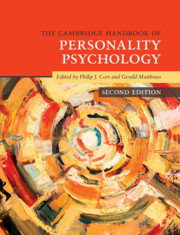Book contents
- The Cambridge Handbook of Personality Psychology
- Cambridge Handbooks in Psychology
- The Cambridge Handbook of Personality Psychology
- Copyright page
- Contents
- Figures
- Tables
- Contributors
- Preface
- General Introduction
- Part I Foundational Issues: History and Approaches to Personality
- 1 Conceptual and Historical Perspectives
- 2 The Trait Approach
- 3 Accuracy in Person Perception
- 4 States and Situations, Traits and Environments
- 5 Personality and the Unconscious
- 6 Personality and Emotion
- Part II Description and Measurement: How Personality Is Studied
- Part III Development, Health and Change: Life Span and Health Outcomes
- Part IV Biological Perspectives: Evolution, Genetics and Neuroscience of Personality
- Part V Cognitive and Motivational Perspectives: Dynamic Processes of Personality
- Part VI Social and Cultural Processes: Personality at the Intersection of Society
- Part VII Applications of Personality Psychology: Personality Traits and Processes in Action
- Addendum: Statistical Analyses and Computer Programming in Personality
- Index
- References
1 - Conceptual and Historical Perspectives
from Part I - Foundational Issues: History and Approaches to Personality
Published online by Cambridge University Press: 18 September 2020
- The Cambridge Handbook of Personality Psychology
- Cambridge Handbooks in Psychology
- The Cambridge Handbook of Personality Psychology
- Copyright page
- Contents
- Figures
- Tables
- Contributors
- Preface
- General Introduction
- Part I Foundational Issues: History and Approaches to Personality
- 1 Conceptual and Historical Perspectives
- 2 The Trait Approach
- 3 Accuracy in Person Perception
- 4 States and Situations, Traits and Environments
- 5 Personality and the Unconscious
- 6 Personality and Emotion
- Part II Description and Measurement: How Personality Is Studied
- Part III Development, Health and Change: Life Span and Health Outcomes
- Part IV Biological Perspectives: Evolution, Genetics and Neuroscience of Personality
- Part V Cognitive and Motivational Perspectives: Dynamic Processes of Personality
- Part VI Social and Cultural Processes: Personality at the Intersection of Society
- Part VII Applications of Personality Psychology: Personality Traits and Processes in Action
- Addendum: Statistical Analyses and Computer Programming in Personality
- Index
- References
Summary
Personality, including abnormal as well as normal personality, is arguably the most emblematic psychological area for outsiders, but a consensual definition of the field is elusive. In attempting to study the whole functioning of individuals, personality draws from other areas of psychology: biological, cognitive, social and developmental, to list a few. It has close ties to nonpsychological areas: history and politics, literature and the arts, health sciences and others. Weaving this diversity into a coherent whole remains a conceptual challenge.
- Type
- Chapter
- Information
- The Cambridge Handbook of Personality Psychology , pp. 13 - 30Publisher: Cambridge University PressPrint publication year: 2020
References
- 3
- Cited by

